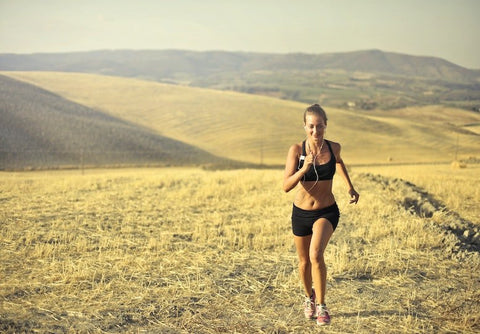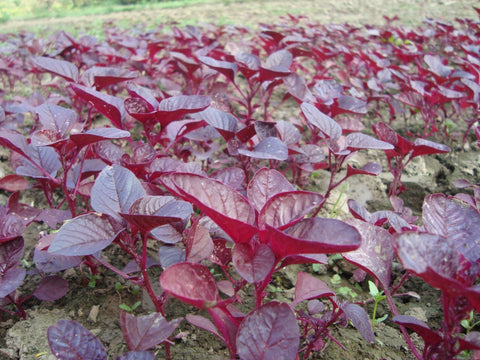How to Improve Circulation
The road to a healthy circulatory system is paved on 100,000 miles of good choices. That's how many miles the adult human circulatory system is when laid out end to end. Yet while our vascular pathway spans four times the circumference of the earth, it's an easy thing to forget about them when everything is functioning correctly. But, when signs of diminished circulation begin to show, it's imperative to know about this vital and complex system in our bodies so you can know when and how to improve circulation. Our bodies rely on oxygen for survival, and our arteries serve as the essential transporter.
Lifestyle choices can impact the health of our circulatory system. Foods that we eat can either help or harm circulation, and whether we have an active or sedentary lifestyle can also make a significant impact. This is often why low energy and bloating are associated with poor diet and exercise. Knowing the signs are important to addressing just how to improve circulation.
Signs that your circulation needs improvement
While we don't want to wait for a problem to arise to start taking actionable steps for a healthy circulatory system, there are signs to watch out for that indicate more immediate improvements are necessary, including:
- Digestive issues
- Fatigue
- Numbness in the hands and feet
- Tingling in the hands and feet
- Swelling in feet, ankles, and legs
- Difficulty concentrating
- Memory Loss
- Joint and muscle cramping
- Skin discoloration
- Ulcers in the legs or feet
- Cold hands and feet
- Varicose veins
Factors that impact the health of the circulatory system include:
- Age
- Diabetes
- Lifestyle
- Obesity
- Smoking
Nitric oxide and circulation
There are many ways to address how to improve circulation; many of the ways to increase nitric oxide also subsequently improve circulation. And there’s a reason for that; nitric oxide gas is responsible for dilating and constricting blood vessels. Thus when nitric oxide levels are improved, so follows circulation.
Here are the top 4 lifestyle changes to enhance circulation for the long term.
Eat the right foods
A plant-based diet is imperative for improving circulation. Foods that are rich in nitrate and improve anti-aging efforts are also great for circulation.
- Beets
- Red & Green Spinach
- Leafy Greens
- Citrus Fruit
- Pomegranates
- Dark Chocolate
- Ginger
- Tumeric
- Berries
- Walnuts
- Almonds
- Garlic
- Grapes
- Chili
- Cinnamon
Hydrate with water, tea, and pure juices
Dehydration happens more often than you might imagine. It's easy to forget to hydrate when you're in the middle of work or your favorite activity. Varying stages of dehydration are important to keep an eye out for; here are some symptoms to be mindful of.
Signs of dehydration:
- Thirst
- Dry mouth
- Flushed skin
- Bad breath
- Muscle cramps
- Headaches
How to improve circulation with what you drink

When we think of staying hydrated, we often focus on water. And while water is the primary source of hydration, it's good to consider other powerful hydrating beverages. Some of those include high antioxidant teas, berry beverages, high nitrate plant-based juices that amplify nitric oxide. Here are some of those drinks to consider for optimal hydration.
Top drinks for staying hydrated and increasing circulation:
- Water - should be the primary source of hydration
- Green Tea - rich in antioxidants
- Black Tea - rich in antioxidants
- Citrus drinks - rich in antioxidants
- Fresh juice - a great source of hydration and nutrients
- Beet juice - a rich source of nitrate and vitamins
- Red Spinach juice - high in nitrate
- Pomegranate juice - high in antioxidants
Ways to manage optimal hydration
Barriers to optimal hydration can range from forgetfulness to disinterest, but optimal hydration is essential for improving circulation. Here are some ways to support hydration:
- Water Intake Tracking App - Thirsty Water App helps you keep track of water intake.
- Water filtration - Home systems for delicious filtered water like Flowater and Berkey.
- Refillable Water Bottle - A refillable bottle can be measured and tracked throughout the day. On the go, you can grab filtered water in a reusable bottle from Path.
- Shaker - A shaker on hand can help hydrate with your favorite plant-based powder beverage.
Get active

In a recent study published on circulation, the role of exercise was examined in middle-aged participants with a sedentary lifestyle to see if improvements in circulation could be made. Study participants engaged in two years of high-intensity workouts. With a completion success rate of 88%, the study showed that exercise has the potential to reverse some impacts of a sedentary lifestyle on the heart.
Another examination of the role of exercise on circulation validated four decades of research on the topic as well as expert input from the Center for Disease Control and Prevention (CDC), the American College of Sports Medicine (ACSM), and the American Heart Association (AHA). The biggest outcome of this research is the determination that approximately 250,000 deaths are attributed to a lack of regular exercise or any physical activity.
Since activity levels are directly tied to how to improve circulation, here are some low and high-impact ways to stay active.
Hiking - Use apps like AllTrails to track and conquer exciting hikes.
Walking - Join a walking group to hold you accountable. Use Meetup Walking Groups to learn about walking groups near you.
Peloton - When the outdoors become harsh, leverage indoor equipment like Peloton that is interactive, engaging and tracks progress.
Team Sports - Join a local team sport to stay active, social, and accountable.
Yoga - Whether at home or in a studio, yoga is a great way to get the body moving.
Biking - When possible, ditch your car and ride a bike to get some extra blood pumping activity in.
Kayaking - If you're lucky enough to live by a body of water, going for a kayak or paddleboard ride can be adventurous.
Trampoline - Trampolines are a great way to get oxygen flowing and improve circulation immediately.
Nitric Oxide Dump - A sequence of short movements to get nitric oxide and oxygen flowing fast; learn more about the benefits of a nitric oxide dump here.
Massage & dermal activation

Regular dermal activation and massages are important to incorporate when looking for how to improve circulation. A study from the University of Illinois Chicago showed that massage therapy improves circulation. While exercise packs a better circulation punch, adding massages to your weekly or monthly schedule can help reduce stress and get nutrients flowing. Some of the most effective massages are effleurage, wringing, and lymphatic drainages for improving circulation.
Dry brushing skin has also become a popular method for removing dead skin cells and improving circulation. According to Dr. Shilpi Khetarpal of the Cleveland Clinic, "Dry brushing unclogs pores in the exfoliation process. It also helps detoxify your skin by increasing blood circulation and promoting lymph flow/drainage."
Types of massages and skin treatments to improve circulation
Deep Tissue Massage - Helps release toxins through slow deep strokes and direct pressure along the muscle's grain.
Manual Lymphatic Drainage - Gentle, rhythmic stretches of the skin that help increase lymphatic fluid movement.
Pfrimmer Deep Muscle Therapy - Works paralyzed and stiff muscles akin to a kink in a garden hose.
Leg massage - aiding in the prevention of varicose veins, leg massages help by relieving pressure and stagnation in the leg muscles.
Swedish Massage - Designed for stimulating circulation, involves applied pressure on bones and muscles.
Thai Massage - A combination of passive stretching, acupressure, and compression to increase joint and muscle range of motion.
Stress Management

A recent study by the American Heart Association confirmed that stress-induced the reduction of blood supply to tiny vessels and that this occurrence happens more often in women. For men, the reduced blood supply was typically a result of mental stress-related blood pressure increases, which also increased workload on the heart. What these studies have in common are the findings that confirm stress negatively impacts circulation.
The bottom line is, stress comes in many forms and is never good for overall health, including circulation. In order to reverse, calm, and prevent stress ahead of time, it's vital to implement stress-reducing measures.
Here are some everyday tools and tips to help manage stress when learning how to improve circulation:
- Headspace App - a meditation app for busy people
- Calm App - guided meditations and more to help on the "journey to calm the mind"
- Fitbit - tracking your activity levels and sleep patterns can help prevent and reduce stress
- Talkspace - repped by Olympian Michael Phelps, is a subscription platform for therapy
Bringing circulation full circle
Improving circulation is all about improving an overall lifestyle first and foremost. Scientifically, circulation improvement is doable, and the best way to take action is to make long-term sustained changes in everyday habits. To recap, the top practices to focus on include:
- Getting daily physical activity
- Eating the right foods that boost nitric oxide
- Drinking plant-based beverages that hydrate and deliver antioxidants and nitrate
- Getting a massage
- Taking measures to reduce stress
What starts as a quest to learn how to improve circulation ends with a better quality of life.
Resources:
Weiqun Shen, Thomas H. Hintze, and Michael S. Wolin. Circulation. Volume 92, Issue 12, 15 December 1995; Pages 3505-3512. https://doi.org/10.1161/01.CIR.92.12.3505
Erin J. Howden, PhD, Satyam Sarma, MD, Justin S. Lawley, PhD, Mildred Opondo, MD, William Cornwell, MD, Douglas Stoller, MD, PhD, Marcus A. Urey, MD, Beverley Adams-Huet, MS, and Benjamin D. Levine, MD. Reversing the Cardiac Effects of Sedentary Aging in Middle Age—A Randomized Controlled Trial. Circulation. Volume 137, Issue 15, 10 April 2018; Pages 1549-1560. https://doi.org/10.1161/CIRCULATIONAHA.117.030617.
Jonathan Myers, PhD. Exercise and Cardiovascular Health. Circulation. Volume 107, Issue 1, 7 January 2003; Pages e2-e5. https://doi.org/10.1161/01.CIR.0000048890.59383.8D
3 University of Illinois at Chicago. "Massage therapy improves circulation, alleviates muscle soreness." ScienceDaily. ScienceDaily, 16 April 2014. www.sciencedaily.com/releases/2014/04/140416125434.htm
The Truth About Dry Brushing and What it Does for You. https://health.clevelandclinic.org/the-truth-about-dry-brushing-and-what-it-does-for-you/
Samaah Sullivan, Muhammad Hammadah, Ibhar Al Mheid, Kobina Wilmot, Ronnie Ramadan, Ayman Alkhoder, Nino Isakadze, Amit Shah, Oleksiy Levantsevych, Pratik M. Pimple, Michael Kutner, Laura Ward, Ernest V. Garcia, Jonathon Nye, Puja K. Mehta, Tené T. Lewis, J. Douglas Bremner, Paolo Raggi, Arshed A. Quyyumi, Viola Vaccarino. Sex Differences in Hemodynamic and Microvascular Mechanisms of Myocardial Ischemia Induced by Mental Stress. Arteriosclerosis, Thrombosis, and Vascular Biology, 2017; ATVBAHA.117.309535 DOI: 10.1161/ATVBAHA.117.309535





Comments (0)
There are no comments for this article. Be the first one to leave a message!